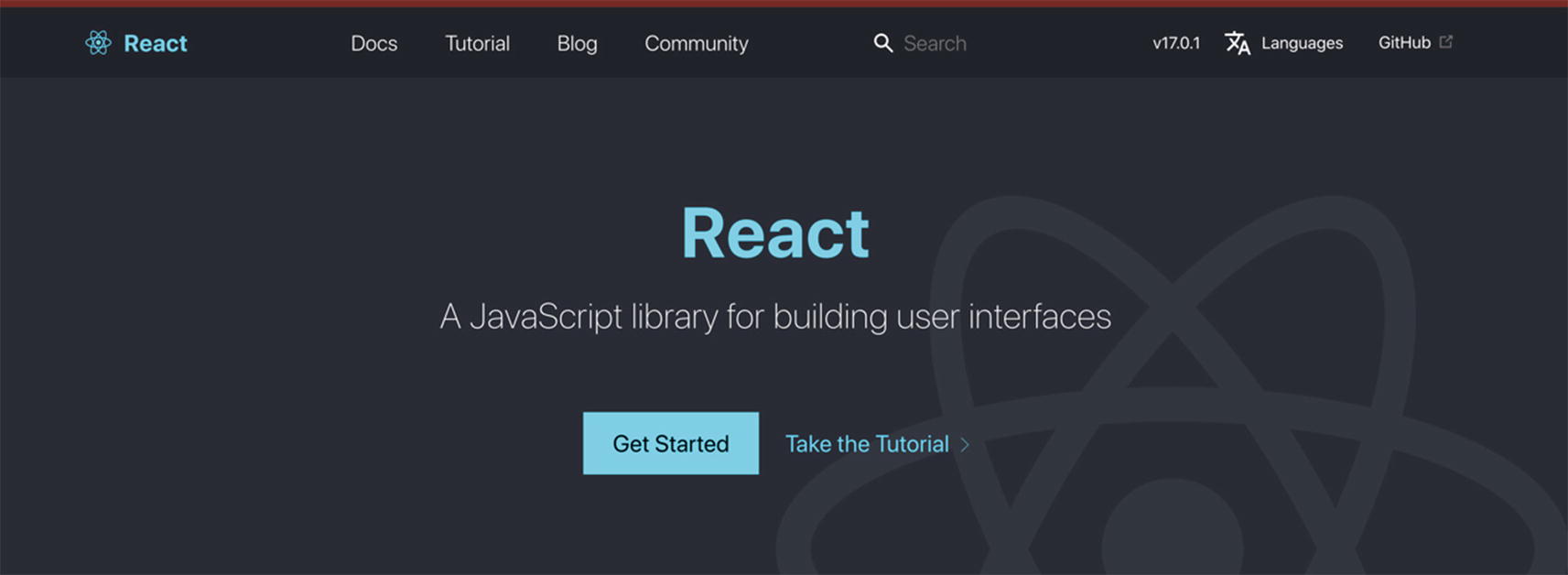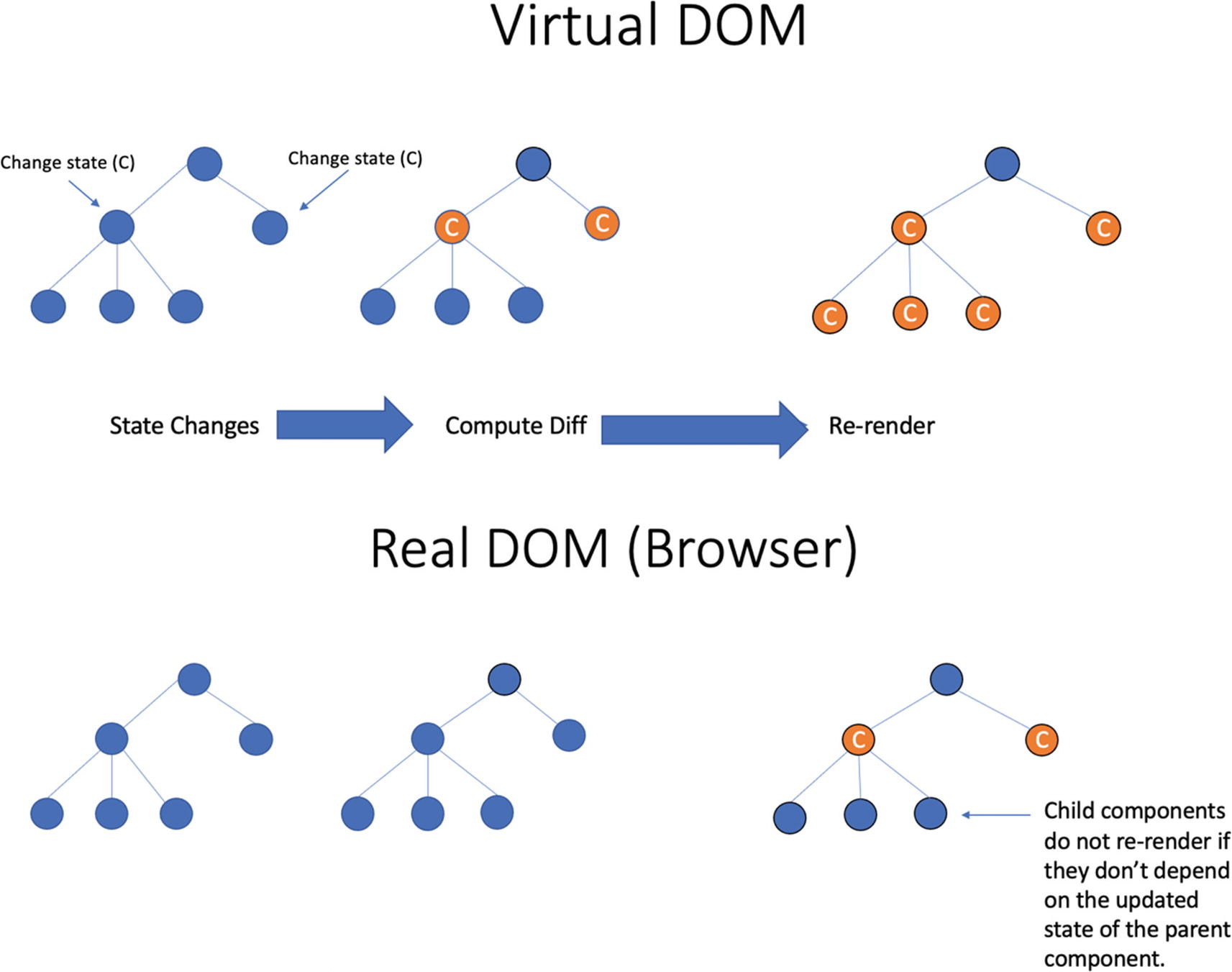This chapter will cover a short overview of some key React concepts, including the advantages and potential benefits of having React as part of your front-end development arsenal.
React Primer
React is an open source JavaScript library for creating interactive user interfaces (UIs) and front-end applications. And its ever-increasing number of users and the robust community around the world are probably a testament to the fact that React is fulfilling its raison d’être, developing user interfaces, in particular, faster and interactive user interfaces.
You “declare” how you want your UI to look like and how it should behave, and React will follow your instructions and render it in your browser as per your description.
Facebook created React in 2011, which became open source in 2013. React is technically a library, but many users glibly refer to it as a framework because of its behavior and capabilities. Perhaps, one way to describe or compare how React behaves is to think of it as the View in the popular architectural pattern Model-View-Controller (MVC).
Component-Based Architecture
At its core, a React application is made up of components. Reusable components to be more precise. It is a section or a piece of the user interface, and each element has its specific logic.

A screenshot of a typical website. Source: www.reactjs.org

An example of a navbar component

An example of a hero section component
So if you examine it closely, React components are small independent and self-contained blocks of reusable codes that we can put together to create complex user interfaces.
Yes, a React application is composed of many reusable components. Components can be thought of in any programming language as simple functions. The root of every React app is an element aptly called the root component that holds together the entire application, including all its child components.
Document Object Model (DOM)
Another concept worth understanding when learning React is its Virtual Document Object Model , or Virtual DOM for short.
Simply put, a Virtual DOM is merely a representation of the Real DOM.
A change in data or state is done first on the Virtual DOM. After the changes are computed, that’s when the Real DOM is updated. The result? Overall fast performance and better user experience. React only re-renders the components and their children where an element of state has changed.
If the data changes, the entire UI in the Virtual DOM is re-rendered.
The re-rendering creates a new Virtual DOM with the corresponding changes.
Next, a comparison of the differences between the old and new Virtual DOMs is made or calculated.
The Real DOM is then updated ONLY with the elements or states that have changed, not the whole DOM tree.
So, yes, the ingenious creation and use of the Virtual DOM is one of the reasons why React is fast.

Child components only re-render if their states depend on the parent component

Child components do not re-render in the Real DOM if they don’t depend on the updated state of the parent component
In Figure 1-5, changing the parent state will NOT re-render the children IF the child components DO NOT depend on the updated state of the parent component.
Performance-wise, accessing or creating the Virtual DOM is cheap compared with building or re-rendering in the Real DOM.

Comparison table between the Real DOM and the Virtual DOM
Client-Side Rendering and Server-Side Rendering
You can opt to do your React application either through client-side rendering (CSR) or server-side rendering (SSR). Developers can build independent and self-contained components of the app on the client side as well as on the server side.
Client-side rendering (CSR), a relatively new way to render websites, is about displaying content in the UI using JavaScript. There are certain performance advantages when you run your code on the client side, including making your interface much more interactive every time you make changes to your code. When data change, React will efficiently update and re-render our components.
The initial page load on CSR is supposedly slower, but page reuploads can become very fast because the entire UI is not called on the server.
React server-side rendering (SSR) means components are rendered on the server, and the output is HTML content. One argument for doing SSR is that it has a better application performance, especially for content-heavy apps; another one is that the HTML output is more SEO-friendly compared with doing CSR.
Unidirectional Flow/One-Way Data Binding
React is made more for unidirectional flow or one-way data binding. The downward data flow is one of the things that allow for faster and more efficient (not to mention easily testable code) developing times in React.
The unidirectional data binding allows you to control your application development better because components are supposedly immutable and data within them cannot be changed. To edit any element directly, one has to use the callback function.
Why React?
React has not only a fast-learning curve compared with other frameworks, libraries, or programming languages; it is also back end agnostic, which allows for users to use it whatever their stack is. JavaScript developers, in particular, can quickly become proficient in React development.
A big bonus point is a well-written documentation on its official site that is easy to follow and understand. You can think of React as the WordPress of the CMS (Content Management System) world because most of your problems can be solved by installing open source libraries.

Reasons to learn and use React
Figure 1-7 illustrates why React has become a favorite of developers and many prominent business brands.
The power of the Virtual DOM in React. It updates and renders only the elements that likewise update and generate in the DOM.
Quick rendering and reusable components. Create encapsulated, independent components that can be reused within or outside the project.
React can be rendered on a server using Next.js.
To develop mobile apps, you can use React Native, a mobile app development framework using React. Moreover, you can reuse business logic parts of a React web app in your React Native mobile app.
React is relatively easy to learn compared with other JavaScript frameworks or even other front-end frameworks such as Angular or Ember.js.
A wide array of tools to choose from, including React DevTools, Redux DevTools, and MobX DevTools.
React is open source with a robust ecosystem of active communities or groups around the world.
The last one, the big React community and support, is a significant factor, whether you believe it or not. This active community also translates to developers creating many tools and third-party libraries to help you in your developing experience.
Based on personal experiences, we have turned for help to many React groups like Slack, Gitter, Facebook groups, Discord, Spectrum, and Twitter. Or we reach out to a particular individual whenever we get stuck on something or need a bit of clarification.
Almost always, we get an answer from someone, and usually in less than an hour in our experience, maybe because the active members are based globally and in different time zones.
Career Opportunities in React

Interest overtime in React, Angular, and Vue. Source: https://trends.google.com/trends/explore?date=2019-09-01
If you want to expand your hiring desirability as a front-end developer and a full-stack developer, mastering React is the way to go.
React developers currently have a high job market demand and in the foreseeable future. Yes, it might be understandable that you could have a favorite language or library or framework. Still, to be blunt about it, one of the criteria for learning a new language or a new programming tool should be how hirable you would be, whether as a freelancer or as part of a company.
Summary
This chapter covered an overview of crucial React concepts, including the advantages and benefits of learning React. We learned that the core of all React applications are its reusable components and how Virtual DOM allows for overall fast performance and better user experience.
Another reason why React has become so popular is because it gives developers the possibility to build and render independent and self-contained components on the client side and the server side. Lastly, we showed that React skills are a good career move as interest and demand continue to grow.
In the next chapter, we will begin to download and install software packages that we will need to build our React application.
